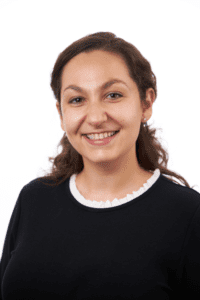Posted By: Kylee Spencer, PhD, Assistant Editor, AJHG
Each month, the editors of The American Journal of Human Genetics interview an author of a recently published paper. This month we check in with Elizabeth (@egatkinson) to discuss her recent paper “Genetic structure correlates with ethnolinguistic diversity in eastern and southern Africa”.

KS: What motivated you to start working on this project?
EA: The Neuropsychiatric Genetics in African Populations (NeuroGAP-Psychosis) initiative is a key effort to decrease the burden of serious mental illness in Africa. The NeuroGAP-Psychosis study team had already been hard at work for several years before I joined this project getting the foundational logistics all set up and launching collections in the five locations described in this manuscript. Starting my postdoc at the Broad, I had the honor of being able to analyze the genetic data from the pilot chips coming back from each site, presented for the first time in this manuscript, and began exploring the structure of their genetic variation. I was struck at the high level of diversity both across and within sites; in particular, in some of our east African sites, samples collected at the exact same location were appearing strikingly genetically differentiated. Digging into what explained this differentiation, when I stratified samples by the language they spoke it broke really cleanly with the genetic split. This sparked the bigger line of questioning that we pursue in this manuscript – how does language, geography, and cultural diversity partition with genetic diversity in our samples from eastern and southern Africa? We could address this question in a comprehensive way by making use of the unusually rich level of familial information we collected in recruiting participants to the NeuroGAP-Psychosis collection – we have self-reported data from participants for not only their first but also second and third language and ethnicity, and for not only themselves but also their parents and all grandparents. This let us take a close look at both the current snapshot of who we have in the NeuroGAP-Psychosis collection, and how endorsed languages have shifted in frequency over three generations.
KS: What about this paper/project most excites you?
EA: There are several aspects of this work that I find really interesting. I think bringing in other elements to put genetics into context is important and fascinating. Thinking about how language and geography interface with genetics speaks not only to the expectations for patterns of genetic variation, which is informative for statistical genetics, but also the population genetic and evolutionary history of modern groups. I come from a population genomics background, so am excited about bringing in that historical perspective to understand and contextualize modern genetic variation.
Another aspect of this work that I am really excited about and want to highlight is the large contribution from trainees in the Global Initiative for Neuropsychiatric Genetics Education in Research (GINGER) program. The GINGER program is working to expand genetic research capacity through training and mentoring of early-career researchers globally, and I had the privilege of working closely with three of our GINGER fellows, co-second authors on this manuscript, to conduct several of the analyses presented including the language transmission tests, investigations into sex-biased demography, and examining the frequency of functionally relevant variants across regions of Africa. It was wonderful working with them over recurrent meetings remotely, but even more fun to see them in person in annual trips to partner institutions in Africa where myself and other Harvard Global Teaching Fellows taught genomics research methods training, got to spend some in-person time with NeuroGAP-Psychosis PIs and GINGER Research Fellows, and learn about the research at our partner institutions.
KS: Thinking about the bigger picture, what implications do you see from this work for the larger human genetics community?
EA: As a community we need to strive both for more equitable representation of diverse samples in genomics datasets, as well as an inclusive scientific workforce that reflects the global population. NeuroGAP-Psychosis and GINGER are working towards both of these goals hand in hand, and I hope that they can serve as a model for other consortia. Building meaningful and equitable partnerships is so vital in conducting international research.
KS: What advice do you have for trainees/young scientists?
EA: Don’t be afraid to fail! Nobody likes doing things they’re bad at, and when you first start learning something it’s going to take awhile to get good. That’s ok, and well worth pushing through if it’s a topic you’re interested in.
KS: And for fun, tell us something about your life outside of the lab.
EA: I love trying new foods, playing elaborate board games, and hanging out with my cat, Mochi.
